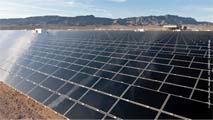DOI's Salazar joins Enbridge, First Solar to turn first PV project on BLM land
 There’s been plenty of uproar and support for installing solar projects on lands managed by the Bureau of Land Management (BLM) but the first project, the 50 megawatt Silver State North photovoltaic project is now complete. During the project’s commissioning ceremony on May 7, Department of Interior Secretary Ken Salazar was there to flip the switch on the project, which is owned by Enbridge and was built by First Solar.
There’s been plenty of uproar and support for installing solar projects on lands managed by the Bureau of Land Management (BLM) but the first project, the 50 megawatt Silver State North photovoltaic project is now complete. During the project’s commissioning ceremony on May 7, Department of Interior Secretary Ken Salazar was there to flip the switch on the project, which is owned by Enbridge and was built by First Solar.
The project was built on BLM land south of Las Vegas in Nevada’s Ivanpah Valley. “Today is about making believers out of skeptics," Salazar said. "As the first solar project on U.S. public lands completed and ready to deliver energy to thousands of homes across Nevada, the Silver State North Solar Project is really at the forefront of our nation's clean energy economy.”
The project is complete but is still in the process of turning on the entire power plant, according to Enbridge spokesperson Larry Springer. “It is commissioned,” he said. But they are in the process of turning the plant on because, NV Energy, which is purchasing the plant’s generation through a 25-year power purchase agreement, has to bring the power online.
Although Enbridge has traditionally been an energy transportation company, with the world’s largest network of oil pipelines, it’s increasingly been involved with renewable energy, and now owns nearly 1 gigawatt of renewable energy capacity in the U.S. and Canada. In fact, it isn’t even Enbridge’s first project with First Solar, according to Springer. “We’ve had several other projects with them in Canada. Including the very large project in Sarnia, which was one of the world’s largest ones until just recently,” he said.
The completion of projects like Sarnia and Silver State North shows the advances that solar has made. “The good news is that the technology is getting cheaper and better, and more reliable,” Springer said. We’re very comfortable with that,” Springer said. “We’re looking for other opportunities [for solar]. In the U.S. there are several that we’re looking at and we’ll continue to evaluate those as they come up.”
Since the project was located on BLM land, which may have been more pristine than other lands, protective measures were taken to reduce the impact on desert tortoises. “We have a very extensive tortoise program. Everybody who came out there…has to spend several minutes to go through tortoise training,” Springer said. The site is also fenced off and if any tortoises are found, the BLM is notified so it can decide how to handle the situation.



